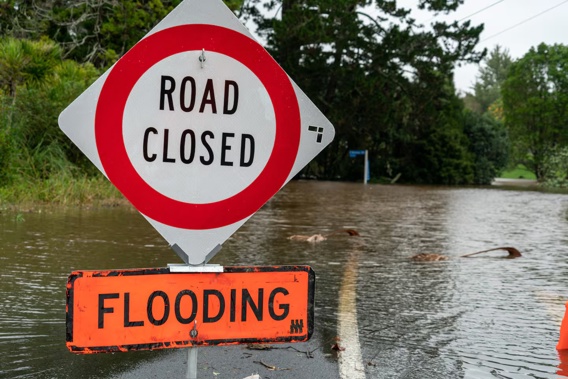
By Amy Williams of RNZ
A woman whose Auckland state house flooded and tilted dangerously on the night of last January’s storm was not told it was on a flood plain and says she was assured it was a safe place to live.
When Kelly Dey and her four children moved into a new two-storey house in Māngere in 2019, she thought nothing of the nearby creek.
“When I first moved them to that house, Kainga Ora turned around and told me that it was a million-dollar house and that it was safe for your family and to keep it clean and, you know, make it your own house.”
But the house on Ventura St was built on a flood plain, near Te Ararata Stream, which flooded almost 200 nearby homes the night of the January 2023 storm.
That night, Dey was home alone with her four children – two teenagers, a baby and a toddler.
“I could see by about five o’clock the water was coming up, it was actually literally by my house, by the front door,” she said.
“I took all my kids upstairs, took heaps of munchies and everything upstairs, just so that we didn’t have to go back downstairs if the water was to come into the house.”
A few hours later, Dey realised they were in a dangerous predicament.
“About eight o’clock I went downstairs to see how far the water was coming, and by then I could feel the house tilting.”
“[It was] really scary, actually, I didn’t know what I was feeling. I thought ‘Oh this is not right’. And as I was walking down the stairs, it was starting to tilt.”
As she turned to walk back upstairs to her children, Dey could feel the house moving.
“By then I said to all my kids ‘get up, get out, the house is tilting’.”
With the help of her teenagers, she evacuated her family in waist-deep flood waters from the tilting house.
But like others in the neighbourhood, her car was submerged and they fled on foot with a neighbour to higher ground.
Dey said she should have been told the house was on a flood plain because of the potential risk – she had no contents insurance.
“They should be paying for everything that we’ve lost in that house because they’re the ones that turned around and said in the first place that we were safe in that house through natural disasters, that’s what they said.”
Kāinga Ora regional director for Counties Manukau Angela Pearce said the Ventura St house was built to council’s standards for a 100-year storm – not the 200-year storm that hit the region.
“The Auckland rainfall on January 27, 2023, is considered an extreme one in 200-year storm event and exceeded Auckland Council Code of Practice and the required standard of a one in 100-year storm event.”
She said building inspections of the Ventura St house after the flooding showed no faults.
“Post-event inspections confirm that the foundations were built to code and producer statements were issued by applicable engineers at the time of construction.”
Pearce said the extreme water levels created a “buoyancy effect” which “impacted the house and the foundations, resulting in movement”.
She said state housing tenants are not told if their rental is on a flood plain.
“When offering customers a Kāinga Ora home, we generally do not specify if the home is on a flood plain.”
“It is important to note that even if a home is on flood plain, mitigations would generally been put in place to reduce the risk. If customers want to know about any potential natural hazards at a property they are considering moving into, this information is available through the local council.
Pearce said any advice Kāinga Ora received about culpability was legally privileged.
Property lawyer Joanna Pidgeon said although there was no legal obligation to disclose a rental’s risks, it would be best practice.
“If you’re wanting to be a good landlord to vulnerable people if there are risks with the property, best practice would be to disclose them to enable [tenants] to make a choice as to whether that was something that they were okay with or not,” Pidgeon said.
“It might be more important for them to have contents insurance given the risks with the property.”
Compensation claims
Dey said before evacuating her house the night of the flooding, she called Kāinga Ora.
“I explained to them that my house has been damaged, it’s starting to tilt. They says to me that: ‘Oh, could you please hang on, we can help you out with accommodation until we can find you another house’.
“I said ‘Okay then, thank you very much and what am I meant to do tonight?’ They says: ‘Oh, you’ll just have to find somewhere else to stay the night because we can’t help you tonight’.”
Dey said that was a shock.
“I was upset. I didn’t know where I was going. I had no one else.”
She said her neighbour also had to evacuate and offered her family a night at her aunty’s house which they had to walk to with only the clothes on their backs.
“I was up all night. I couldn’t sleep because I had lost everything. I was wet. I had no clothes whatsoever.”
Dey said she and her neighbour had the same tenancy manager at Kāinga Ora, who they called the morning after the flood to find out what to do.
“She was asking her ‘So what do we need to do, you know, are you gonna help us’?
“And she says, ‘What do you mean by helping you? But do you guys want a compensation of 50 to 60 grand? I can ask my manager’,” Dey said.
“And I says: ‘No, what I mean is that you guys should be helping us because it wasn’t our fault that we lost everything in the house. Why should we have to buy everything for our new houses if you guys can’t help us?’,” she said.
“You know, we lost everything in that house. You guys turn around and tell us that it was a million-dollar house and we were safe. We were supposed to be safe in that house.”
Pearce said Kainga Ora had no record of Dey being offered compensation.
Māngere’s flood-proofing
By the middle of this year, Kāinga Ora had demolished 21 flood-damaged homes in Māngere with another 23 in the suburb earmarked for the bulldozers – half the 89 total state homes to be levelled in Auckland.
Auckland Council has continued to grant consent to housing on flood plains and in flood-prone areas since last year’s devastating flooding.
Property lawyer Joanna Pidgeon questioned whether social housing should be built in areas prone to natural hazards.
“Maybe you can build more housing for cheaper if you can get land at a low price in a flood-prone area, however, is that a false economy if you have to remediate and it might not be insurable?”
For now, the house on Ventura St is still standing – Pearce said retaining state housing in the area would depend on what measures are taken to prevent the risk of flooding.
“We are currently working through options for the future use of our Ventura St land in light of the recent decision by Auckland Council to proceed with significant stormwater infrastructure upgrades, which will subsequently reduce flooding risk for homes near Te Ararata Creek.”
Public consultation is underway for council’s stormwater resilience projects in Māngere.
Auckland Council project manager for Māngere Leighton Gillespie said they had received co-funding approval from Government for the first three infrastructure resilience solutions in Māngere’s Te Ararata and Harania catchments, as well as in Muriwai around Domain Crescent.
“In Māngere we are waiting to hear whether an ‘Order in Council’ we requested has been approved, which will allow us to deliver the projects as soon as possible. Consenting for projects like these would otherwise take more than a year given the urban areas we are dealing with.”
The projects would reduce the flood risk for 244 homes in the area and save 51 from demolition.
Construction for both is scheduled for next year with completion in early 2026.
Sign up to The Daily H, a free newsletter curated by our editors and delivered straight to your inbox every weekday.
Take your Radio, Podcasts and Music with you









